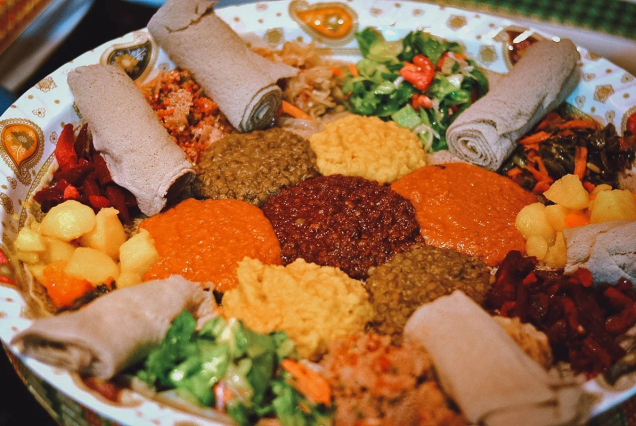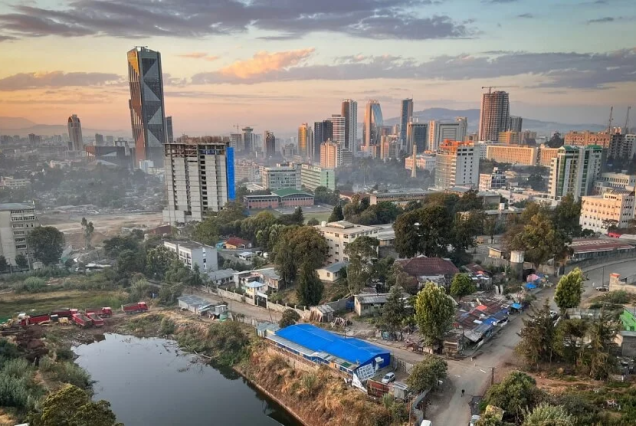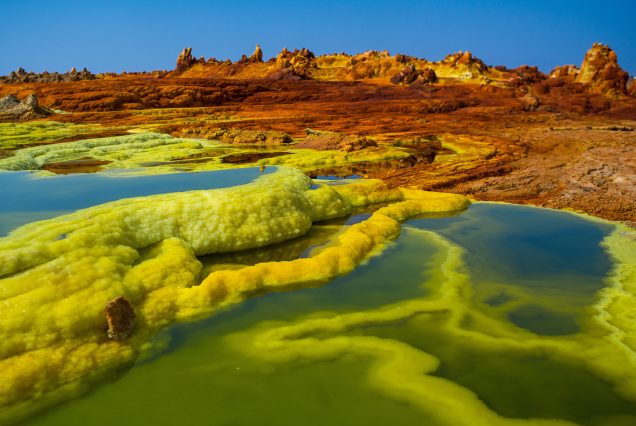Ethiopia. Classic Historic Route. 8 days.
Visiting Addis Ababa often referred as “the political capital of Africa” for its historical, diplomatic and political significance for the continent including the National Museum, St. George Cathedral & Merkato. Visit the “lung of Addis Ababa” Entoto Mountain; it was once a palace and the royal court to Emperor Menelik in the 1800s. The Magnificent Blue Nile falls, and Lake Tana Monasteries. Explore the wild life and landscape of the Simien Mountains & the city of Gondar. Touring through the vivid frescoes of Lalibela‟s rock-hewn churches. This program includes History, culture, religion, different social activities, scenery and wildlife.
| DBL SHA | 3* BB | 3*HB | 3*FB | 4* BB | 4*HB | 4*FB | 5* BB | 5*HB | 5*FB |
|---|---|---|---|---|---|---|---|---|---|
| 2 pax | 2395 | 2475 | 2555 | 2575 | 2655 | 2735 | 3210 | 3290 | 3370 |
| 3 pax | 2100 | 2180 | 2260 | 2280 | 2360 | 2440 | 2910 | 2990 | 3070 |
| 4 pax | 1915 | 1995 | 2075 | 2095 | 2175 | 2255 | 2730 | 2810 | 2890 |
| 5 pax | 1810 | 1890 | 1970 | 1990 | 2070 | 2150 | 2630 | 2710 | 2790 |
| 10 pax | 1560 | 1640 | 1720 | 1740 | 1820 | 1900 | 2380 | 2460 | 2540 |
Included/Excluded
- All accommodation as per the selected category, with shared room and private facilities
- Selected meal plan
- Meeting at the airport and transfer to the hotel
- Cultural activities as per the program
- All entrance fees as per the program
- Other activities Coffee ceremony and drinks with honey wine (Tej)
- Traditional Farewell Dinner in Addis Ababa
- Visa to Ethiopia
- International and domestic flights
- Insurance coverage for personal loss, injury, illness or damage incurred during the trip
- Personal expenses
- Transfers, excursions or meals not included in the program
- Gratuities
Tour Plan
Addis Ababa is the largest city of Ethiopia and its capital city at the same time. Addis Ababa, which in Amharic means “a new flower”, is located in the center of the country, 2100- 2300m above the sea. It is one of the highest-located capital cities in the world. Addis Ababa is a pleasant city with interesting museums and one of the largest open-air markets in Africa, “Mercato”.
Addis Ababa is Africa’s diplomatic capital with headquarters for the Organization of African Unity and the United Nation Economic Commissions for Africa.
On your arrival at Addis Ababa Bole International Airport, after clearing immigration and customs welcome by your guide and get transferred to your hotel.
Depending on your arrival time it is possible to arrange sightseeing in Addis Ababa with a national guide and this includes.
A visit of the National Archaeological Museum; ranks among the most important museums in sub- Sahara Africa. It housed the 3.5 million-year-old bones of Lucy. Lucy is believed to be the ancestor of all Human kind. It has lots of ancient exhibits that reflect the importance of Ethiopia as the “Cradle of Mankind‟. Its historic room features finery worn in the wars, such as crowns, weapons, and pictures of wartime heroes and kings.
Visit St. George’s Cathedral (Giorgis Cathedral) which lies at the north end of Churchill Rd. Designed in the traditional octagonal shape, this cathedral was built in 1896 to commemorate Ethiopia’s victory over the Italians at the Battle of Adwa. The Cathedral houses the work of Afewerk Tekle, the renowned Ethiopian artist responsible for the stained glass windows of the Africa Hall and also houses a small museum in the compound.
And a visit of Merkato; the Largest open Market in Africa; where virtually every possible commodity is on sale, from livestock to computers. It is closed on Sundays & for a visitor good at bargaining, there is a huge selection of Ethiopian arts and crafts.
Accommodation: Best Western Plus Addis Ababa Hotel/Hyatt Regency Addis Ababa Hotel/ Sheraton Addis Luxury Collection
In early morning, following your breakfast transfer to Addis Ababa (Bole) int. airport for your flight to Bahir Dar (1hr flight). ET 126 ADD – BJR 7:10 am – 8:20 am.
Bahir Dar is one of the best well-planned cities in Ethiopia, which means “by the side of the sea”. Bahir Dar is the third largest and arguably the most beautiful city in Ethiopia. As the capital for the regional state of Amhara, the city is home for historic monasteries, charming lodges, exotic fish markets, beautiful lakes and of course the famous Blue Nile Falls. There are dozens of islands found on Lake Tana, and many are home to 14th Century monasteries complete with ancient ornaments, frescoes, and fascinating wall paintings.
After check-in to your hotel go for the alluring Blue Nile Falls, “Tiss isat” (smoking fire), the Falls are 328 feet wide and the water cascades down a 150 feet, high drop to produce a dazzling spray of mist and rainbows, shimmering across the gorge, and a small perennial rainforest of lush green vegetation, to the delight of the many monkeys and multi-colored birds that inhabit the area. The Blue Nile Falls is 32kms from the city. On a clear sunny day you can walk for about 30min walk to the base of the falls. Meet with the locals around for a short coffee break. Cotton spinning is the most famous activity in this area.
Following lunch, explore the 12th-14th century treasured Monasteries of Lake Tana by a cruise, round, grass roofed of the Zeghie Peninsula,, witness the Ethiopia’s links with the ancient world by the papyrus Tankwa that sail the lake bear a striking resemblance to the boats of Ancient Egypt.
Visit the round, thatched roof of the Azuwa Maryam Monastery along the Zege Peninsular makes this church one of the most aesthetically pleasing. Then move to one of the bigger monasteries in the region, Ura Kidane Mehret is known for its beautifully painted, psychedelic murals that run the perimeter of its circular straw walls. Just 25minute‟s walk from the boat landing point, Ura Kidane Mehret is one of the more accessible churches in the region and is by far the most popular.
Concealed behind tall shady palm trees and densely planted coffee farms, the monastery houses vibrant frescoes depicting scenes from Ethiopian folklore and Christianity. Both men and women are permitted entry and there is a small museum on-site, called the Zege Satekela Museum. Here you can learn about the hand-crafted tools and musical instruments that helped shape this vibrant land and that are still in use today.
In late afternoon enjoy a spectacular view of Bezawit hill top, & the open air market of Bahir Dar Agelgil Market to meet up with locals.
Accommodation: Lake Tana Kuriftu Resorts & Spa / Avanti Blu Nile Resorts 4* / Sky Resort
Today after breakfast drive to Gondar city enjoying the scenic view on the way & the local houses. Gondar “the Camelot of Africa,” is the medieval royal city, distinguished by its castles and imperial compound and by its churches, particularly Debre Berhan Selassie, the walls and ceiling of which are completely covered in murals – the angels‟ faces on the ceiling have become a common motif in Ethiopian design. And after lunch you will have sightseeing in Gondar. Gondar was founded by Emperor Fasiladas in 1636 as the royal capital of Ethiopia. For several centuries Ethiopia had been ruled from a succession of temporary capitals and Fasiladas recognized that a permanent capital might help provide greater internal stability. By the time of Fasiladas’ death in 1667 Gondar was the largest and most important city in the empire. It retained its position as the capital of Ethiopia for 250 years, though this status was largely nominal from the late 18th century onwards.
Gondar has now become one of Ethiopia’s largest and most impressive cities, with its walled Royal Enclosure. Gondar’s most famous monuments are its exceptionally well preserved 17th-century castles. The largest and best is that of King Fasilidas. It is a stone-built construction with round turrets and wooden balconies. The king also built a remarkable bath a mile or so outside of town known as the „Pavilion of Delight‟. The Bathhouse of Fasil at which thousands of Ethiopians celebrate Timekat festival every January. This whole complex of buildings is unique in Ethiopia and unlike anything found elsewhere in Africa. Visit the Royal Enclosure or Fasil Gibbi, encompasses the castles of various Gondarene emperors. The Fasiladas Palace; the Quskuam Church (believed to be the home of famous explorer James Bruce during the 1770‟s). After 2-km drive from the town centre visit the bath of King Fasilides. The pool is now the central stage on which the Timkat or Epiphany festival is celebrated in Gondar. Debre Berhane Selassie church with its remarkable walls and ceiling completely covered with murals – the angels‟ faces on the ceiling have become a common motif in Ethiopian design. Tonight you will have a family dinner mostly Ethiopian local foods prepared with the help of the group participation, like in shopping at local palaces, cooking… serving…. We can cook varieties of organic fresh foods from the market. We include halal foods, cooked vegetables….
Tasting Ethiopian Foods – a meal ever made such an impact that it’s become forever seared into your memory? The colors, the presentation, the way the bread felt on your fingertips. It made such an impression that you still think about it twenty, even thirty years later.
Total driving distance 185kms/3hrs.
Accommodation: Gondar Hills Resort 4* /Haile Resort Gondar /Goha Hotel 3* / Maykelo Lodge / Zoble Hote
In early morning leave your hotel and head to the magnificent Simien Mts. National Park via Gondar. Road/ Surface transfer 210kms/2hrs.
The Simien Mts. dramatic topography resulted from the volcanic activity, Ascribed it as the world natural heritage site, graced by exceptional botanical phenomena and a zoo of wild life Walia Ibex, Red fox, and Chilada/ bleeding heart Baboons are few to site.
Visit Sankaber the first camp sight of the Simien Mts. Here you will find one of the most spectacular mountain scenery in Ethiopia. Stop to watch Ghelada Baboons and observe their foraging habits, and take a short walk to a waterfall (the ground here is uneven).
Picnic lunch at a scenic pot can be arranged. On your way back to Gondar visit Project Ploughshare Women’s Crafts Training Centre – Located 5km from Gondar, this centre is focussed on helping disadvantaged women rekindle local pottery traditions, along with Amhara weaving and basketry. Founded in 1993, the aim of the project is to help single mothers who have lost their husbands as a result of HIV/Aids, war, natural disasters or divorce. With an average of 4 to 5 children to support, the proceeds of the products which are sold to the local community and tourists are a vital source of income.
Ras Gimb Museum – Likely built in the 17th century, this attractive palace, now converted into a museum, once served as: a retreat for Haile Selassie; a residence for Italian generals; and as a torture chamber for the Derg. Return back to Gondar city for the overnight stay.
It is possible to add more overnights & trekking in the Simien Mts. if needed.
Road/ Surface transfer 210kms/2hrs.
Accommodation: Gondar Hills Resort 4* /Haile Resort Gondar /Goha Hotel 3* / Maykelo Lodge / Zoble Hotel
Following your breakfast transfer to the airport for your flight to Lalibela ET 122 @10:10 GDQ – 10:40 LLI.
The small town of Lalibela, which is home to one of the world’s most astounding sacred sites, comprising eleven medieval rock-hewn churches, each carved entirely out of a single piece of stone.
Lalibela, the „New Jerusalem‟, was built by King Lalibela „with the help of angels‟ in the 12th century and is a UNESCO World Heritage Site with its eleven rock-hewn churches. Perched among wild craggy mountains and vast rocky escarpments, there is a stark cathedral-like grandeur to Lalibela. The houses of Lalibela are of a design unlike anywhere else in Ethiopia, two-storey circular stone constructs that huddle in an amorphous mass over the steep slopes on which the town is built.
The rock-hewn churches are large and several are more than ten meters high. Because they are carved below ground level, they are ringed by trenches and courtyards, the sides of which are cut into with stone graves and hermit cells and connected to each other by a tangled maze of tunnels and passages.
The eleven rock churches, thought to be at least 200 years old, are divided into two groups and are visited by foot. The steps are uneven and walking around can require a little agility.
After the decline of the Axumite Empire, lamenting their lost grandeur, Ethiopia’s rulers retreated with their Christian subjects to the lofty escarpment of the central uplands. There, protected by mountain battlements more formidable than anything the hand of man could fashion, they were able to repel an increasingly expansionist and militant Islamic army by trapping and confusing their enemies in the precipitous maze of valleys that intersects the high plateau. Inevitably, a fortress mentality took root: an intense suspicion of the motives of strangers, a hatred of intrusion and interference, and a protective secrecy. From roughly the seventh to the 16th century AD, the Ethiopians were encompassed by the enemies of their religion and were described by the British historian Edward Gibbon as having “slept for near a thousand years, forgetful of the world by whom they were forgotten”. It is true, moreover, that in holding back those who sought to destroy their faith, the highlanders also effectively cut themselves off the evolving mainstream of Christian culture. However, this is the only sense in which they slept. Their unique, idiosyncratic civilization was otherwise very much awake, a singular and spirited affirmation of the creative power of the human intellect.
Lalibela, previously known as Roha, was named after the king. The word itself, which translates to mean ‘the bees’, recognizes his sovereignty and the people of the region still recount the legend. Lalibela was born in Roha in the second half of the 12th century, the youngest son of the royal line of the Zagwe dynasty, which then ruled over much of northern Ethiopia. Despite several elder brothers, he was destined for greatness from his earliest days. Not long after his birth, his mother found a swarm of bees around his crib and recalled an old belief that the animal world foretold important futures. She cried out: “The bees know that this child will become king”.
At the end of the 12th and beginning of the 13th century, King Lalibela of the Zagwe dynasty built a series of rock-hewn churches. There are eleven churches in the town named after him, with others in the surrounding countryside. All are still in use today.
It is estimated that the churches took 25 years to construct. For the kingdom based around Roha to have kept a large work force engaged in economically unproductive labour for such a long period means that it disposed of a large economic surplus and was very wealthy. The area was clearly fertile and agriculturally productive, whereas now deforestation and other forms of ecological degradation have made it barren. This area is particularly prone to drought today.
After lunch leave to visit the north-west cluster of churches consists of Bet Medhane Alem, Bet Maryam, Bet Meskel, Bet Danaghel, Bet Debre Sina, and Bet Golgotha. Also included in this tour is the isolated monolith of Bet Giyorgis (the Church of St George). Bet Medhane Alem is the largest monolithic rock-hewn church
Take a part in a traditional coffee ceremony.
Ethiopia’s coffee ceremony is an integral part of the social and cultural life. It is an important cultural ritual that’s been passed from generation to generation. An invitation to attend a coffee ceremony is considered as a mark of friendship or respect and is an example of Ethiopian hospitality.
Accommodation: Sora Lodge /Mezena / Maribela Hotel /Tukul Village Hotel 3*
Today visit the cave church of Yimrehane Kirstos, 40kms from the city, built by the king of the same name before the reign of King Lalibela. The church is constructed inside a cave, in Axumite style, similar to the church at Debre Damo, with alternating levels of wood and stone. If the day meets, attend the yearly celebration of King & Saint Yimrehane Kirstos which is attended by tens thousands of pilgrims from all over Ethiopia, making it one of the most joyous annual pilgrimages in Lalibela. It is celebrated with greater devotion, the congregation wrapped in white shawls sing with joy along with the priests‟ one after the other and among the swaying choir the priests chanting, dancing, and singing around the church letting out a deep boom of the drums and female’s voice respond in a piercing chorus of ululations. Then return back to the town.
Visit the second group of the rock churches. The south-east cluster of churches is more irregular in design than the north-western cluster. Several of the individual churches in this cluster are thought to have been secular in origin, and some predate the reign of King Lalibela by five centuries. The churches in the south-east cluster include Bet Gebriel-Rafael, Bet Abba Libanos, Bet Lehem, Bet Emanuel, and Bet Mercurios. According to legend, Bet Abba Libanos was built overnight by Lalibela’s wife, Meskel Kebre, who was assisted by a group of angels.
You can also visit the Markets in Lalibela see the colorful and variety of offers. Very intense and enlightening experience or participate in tree planting.
Accommodation: Sora Lodge /Mezena / Maribela Hotel /Tukul Village Hotel 3*
Today transfer to Lalibela airport for your flight back to Addis Ababa. Spend the rest of the day at leisure, go shopping or explore the sights of Addis. ET 131@13:20 LLI-14:35.
A day in Addis, visit the Entoto Hills – the best place to get to know Addis Ababa. Mount Entoto is the highest peak in Addis Ababa, reaching 3200 meters above sea level, which allows you to admire the magnificent view of the city and the surrounding area from the top.
This is the first settlement in Addis Ababa, where Emperor Menelik II lived and built his palace in 1887. This historic site offers a unique perspective on the history of Ethiopia’s unique culture. The complex on the summit is home to the Entoto Mariam Church, the Museum of Ethiopian Artifacts, and the Palace of Menelik II.
Apart from its historical significance, as you climb the hill, you will feel a noticeable drop in temperature and the air will be filled with the aroma of eucalyptus trees that grow along the road.
On the way up, roadside stalls sell fresh Ethiopian coffee. Also, if you are interested in traditional Ethiopian clothing, check out the Shero Medu Market. It has a wide selection of beautiful fabrics, shawls, scarves, dresses, tops and jewelry, a great selection and really good gift ideas.
Tonight, you will have a wonderful cultural evening at one of the restaurants in Addis Ababa; Ethiopia is a mosaic of peoples with over 80 languages, different lifestyles, costumes and cultural dances. Take the chance to taste some of these cultural dances and traditional dishes with Tej, a type of wine made from honey.
Accommodation: Sheraton Addis Luxury Collection 5*/Hyatt Regency Addis Ababa Hotel/Best Western Plus Addis Ababa Hotel 4*/Bonanza Hotel
Breakfast, check-out, transfer to the airport for international flight check-in.




















